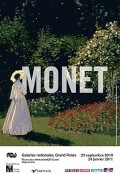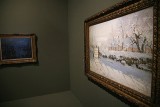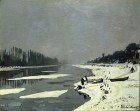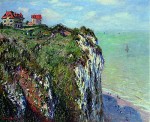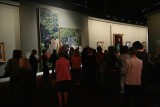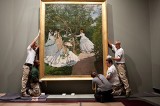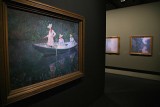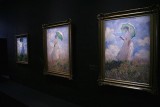The browser will either open the file, download it, or display a dialog.
Claude Monet, 1840–1926
Galeries Nationales, Grand Palais, Paris
September 22, 2010 – January 24, 2011
Catalogue :
Claude Monet, 1840–1926.
With contributions by Guy Cogeval, John House, Laurence Madeline, Sylvie Patin, Sylvie Patry, Anne Roquebert, and Richard Thomson.
Paris: Réunion des Musées Nationaux, 2010.
385 pages; 2T73 color illustrations; 31 black & white illustrations; chronology; list of exhibited works; bibliography; index.
Available in French and English editions.
€ 50.
ISBN: 978 2 7118 5761 6
According to Guy Cogeval, the head of the Musée d’Orsay and head curator of the retrospective exhibition Claude Monet, 1840–1926 at the Grand Palais, Claude Monet has suffered from neglect in his native France. "This is an overwhelming collection of masterpieces. It will revive interest in Monet," he told Radio France.[1] The idea that Monet needs rescuing from cultural oblivion may seem ridiculous to anyone in England and the United States, where scholarship and museum exhibitions on the artist have flourished since the 1980s, but Cogeval's mission to restore interest in Monet comes out of a specifically French context. While it is impossible to know for sure to what extent Monet has fallen outside of public interest in France, left to foreign visitors like the Eiffel Tower, Cogeval's intention to restore the artist's reputation also speaks directly to the dearth of studies on Monet produced by French scholars in recent years. Moreover, according to an article on the state of French scholarship on Impressionism in Le Figaro, three-quarters of the speakers at a symposium on Impressionism at the Musée d’Orsay in April 2010 were from England.[2] This monumental blockbuster mounted by France's Réunion des Musées Nationaux, the official organ of France's national museums, can therefore be seen as an attempt to summon a French contribution to the evolving dialogue on Monet (fig. 1).
The enormous group of paintings assembled by the curators vividly traces the development of the artist's career from his entrée into the Salon of 1865 with The Pointe de la Hève at Low Tide to the Waterlilies made towards the end of his life. The focus is almost exclusively on paintings on canvas, with two notable exceptions toward the end of the gallery; a set of carpets from the Savonnerie, and a painted wardrobe door on loan from the Ontario Art Gallery in Toronto. As a visual experience, the show is unrelentingly sumptuous and serves as a testament to the importance of looking at works of art in person. In this sense, Cogeval's goal of reintroducing viewers to Monet succeeds. Perhaps no artist has been so subject to the banality of reproduction as Monet, and in contrast to the blurred-out images that so often adorn coffee mugs and tote bags, the paintings in this show sparkle with color and texture. The experience of viewing the paintings is aided by the masterfully installed lighting, which avoids reflecting glares (even on glass-covered paintings) and allows their surfaces, including bits of thick impasto and individual brushstrokes, to come into relief.
In ordering this exposition, with 176 works loaned from collections around the world, the curators faced the dilemma of any crushingly huge, all-encompassing blockbuster retrospective: how to make the show both clear and surprising for a general public. Rather than adopting one interpretative framework that would try to contain the breadth of the works on display, they decided to focus, in the words of Richard Thomson, on "several narratives" (84). A general chronological armature underpins the arrangement of small pockets of paintings, each with works that share a location, a genre, or a thematic pattern. This organization prioritizes a focused visual experience of each small number of works rather than an overarching trajectory. Because of this, the layout of the exhibition is at times confusing, as one occasionally jumps around unexpectedly in time. Perhaps the most jarring example comes in the section devoted to Paris, where the Quai du Louvre from 1867 is next to the series from Gare Saint Lazare of 1877: these wildly different works do not serve as useful counterpoints to each other, and confuse any general feeling of Monet's development that a visitor might be gaining.
Ultimately, however, the hybrid organization allows for many dynamic pairings that more than compensate for the occasional sacrifice of clarity. These inspired hangings encourage the close looking and attention to the actual object that is the greatest strength of a large Monet exhibition. Particularly in the first half of the show, the groupings present instructive and thought-provoking juxtapositions that showcase the variety in Monet's early career while simultaneously preparing them for later developments. For example, though they are separated by a key four years in Monet's career, and made with very different intentions, The Magpie (1869) and the Harbor ofLe Havre at Night (1873) are tucked into a corner, facing each other at an angle (fig. 2). The pairing offers an opportunity to explore the artist's commitment to landscape in wildly divergent conditions. The Magpie is the first of several snow paintings in the show and calls attention to a young artist whose practice was geared increasingly towards the depiction of the ineffable quality of effet. Even though the Magpie is named after the small bird perched atop a fence, its true subject is the light generated from the snow-covered terrain. The mostly deep blue and black Le Havre provides a dynamic contrast to the bright light of La Pie. The bits of white and red paint which read as reflections invite viewers to consider the mechanics of Monet's working method.
The main part of the exhibition catalogue is devoted to explaining the logic of these different sections, and does a solid job of introducing them and placing them in the larger context both of Monet's career as a whole and of the greater development of late nineteenth-century art. Instead of individual catalogue entries, the text of the hefty volume is comprised of color reproductions of all the works in the exhibit and essays that correspond to the thematic sections in the exhibition. While informative and written in a style accessible to a general public, it is unclear how the catalogue advances or challenges existing Monet scholarship. Moreover, the English-speaking public is at something of a disadvantage with regard to the catalogue, whose English translation is marred by numerous awkward turns of phrase and would have greatly benefited from a rigorous editorial reading.
The majority of the information contained in the catalogue does not find its way into the galleries, which are remarkable for the dearth of didactic material they offer to visitors: in the entire show, there is not a single wall text devoted to the sustained explanation of one work of art. This absence was likely not an oversight, but rather a conscious decision on the part of the curatorial team to focus on the paintings to the exclusion of "context." However, this huge exhibition, which claims to frame anew for the public the work of Monet, should have offered more of a helping hand to the predictably huge crowds it attracts--especially as its organizing principles are not particularly straightforward. Viewers are hungry for any information that the exhibition grudgingly provides them, and therefore bottlenecks are guaranteed in front of every timeline or introductory paragraph of wall text throughout the first half of the exhibit. Largely, visitors are abandoned to the dry audio guide (€ 5), aggressively hawked by RMN employees at the entrance. Each entry is assigned to a single work, the number for which the listener enters while standing in front of it; however, the texts tend to be longwinded and heavy on biographical and historical background, leaving the viewer standing like a deer in the headlights for minutes on end in front of a painting that other visitors are jostling to be able to see. In this sense, like it or not, the Monet exhibition successfully transports visitors back to the nineteenth century by recreating the crowded spaces of Salon exhibitions often depicted in satirical prints.
The curators present 1890 as an important turning point in Monet's career, and therefore chose to divide the exhibition into two distinct halves on two floors: Monet's works before 1890 are upstairs, and everything later is downstairs. Throughout the first half of the exhibition, the arrangement of the galleries enforces a very strict order of viewing: small areas created by constant partitioning are staggered from side to side, creating one long serpentine line of viewers, with occasional bunching around any block of text. This organization provides enough wall space for the sheer number of paintings in the upper half of the exhibition, which are hung very close together; it also establishes and sharpens focus on the separate groupings of paintings belonging to the different themes adopted by the curators. Unfortunately, the space of the galleries induces a slight claustrophobia in visitors who might feel uncomfortable being forced into lockstep with all their often either annoyed or audio guide-dazed fellow travelers. The first half of the exhibition is at times revelatory and consistently rewarding, but because of the tight space and crowded conditions, it is also hard work.
Two paintings produced during Monet's stay in the Fontainebleau forest in 1865 comprise the first thematic section of the exhibition: a large and small version of the Road to Chailly. The pairing of two paintings of the same parcel of land depicted under varying atmospheric conditions successfully establishes the importance of repetition in Monet's work, a theme which is explored throughout the exhibition. The variation in scale between these two paintings also underscores the artist's ambitions of gaining official acceptance through large-scale landscape painting at this early point in his career. The Fontainebleau paintings are sequestered in a small corner right at the beginning of the upstairs gallery; Monet's early Normandy landscapes dominate the rest of the first room. The large-scale Pointe at La Hève (1865), just across from the large-scale Road to Chailly, offers viewers the chance to consider Monet's formal approach to a painting that was destined for, and accepted at, an official Salon exhibition. In contrast to Chailly, Monet anchors the composition of La Hève with a horizon line and gives the clouds a sense of fluffy depth that he had denied them in the Fontainebleau paintings; he also introduces figures into the scene. The artist's recourse to these conventions of landscape for the benefit of a Salon audience would have made for an informative wall text. Unfortunately, the only information displayed on the wall text includes the title, date and location of each work.
A small walled enclave across from the Normandy section features work made in the environs of Paris, with Argenteuil left for the following larger section. This small space features the two Grenouillère paintings and two works that represent the Seine near Bougainville (fig. 3). The Grenouillère paintings, likely conceived as studies for a larger Salon painting that was never made, provide an opportunity to think about the blurry line in Monet's practice between sketches and finished works. Here, as in other places in the show, one wonders why the curators did not want to bring in works by other artists to contextualize Monet's practice. Renoir's paintings of La Grenouillère would have served this purpose well, just as a Boudin cloud study or painting of life along the Normandy coast would have helped contextualize the previous Normandy section. Due to the prohibitively small area in which these paintings are displayed, this section is particularly afflicted by crowds; nearly every time we visited the exhibition, it was impossible to see these two paintings.
Fortunately, the next section of the gallery is larger. This is where the Argenteuil paintings, made in the early 1870s, are installed. The first painting of the section, the Rail Bridge Under Repair (1871–1872), depicts a bridge that was destroyed during the Franco-Prussian War only a couple of years earlier. The painting does an excellent job of addressing the attraction of Argenteuil for Monet, as a complex site where history, industry and leisure mixed. There is a great deal of variation of subjects in this section, including the oft-reproduced Poppies at Argenteuil (1873) and a dynamic pairing of the Railway Bridge at Argenteuil (1874), the same subject painted during two different times of the day. If the shimmering blue and green tones of some of the paintings in this Argenteuil section reinforce Monet's contemporary public reputation as a painter of picturesque works, the first part of the next section complicates such an understanding of his oeuvre. Perhaps the muddiest Monet painting ever made, the extraordinary Gare d'Argenteuil (1872) is full of brown and spotty splotches of grey and white paint. While the Gare d'Argenteuil looks highly improvised, the painting next to it is much more composed and resolved: Monet's painting of labor in the environs of Paris (in this case, in Asnières), the Coal Workers (1875), features a horizon line, recession into space and a highly worked up surface. The wall leads into a section on Paris, the stand-out painting within which is the shocking Signal (1877), which Monet sold to Gustave Caillebotte as a sketch. As with the Grenouillière section, this part of the gallery is often crowded and difficult to access.
Passing from the Paris wall to the next section, which deals with Monet's time in Vétheuil from 1878–1880, one walks by a series of large images plastered to the wall like wallpaper. They are enlarged photographs of landscapes depicted by Monet, and could have introduced the question of his relationship to photography. However, they are instead treated as pure decoration with no explanatory text provided, and both the photographer and the exact subject matter remain obscure. This omission is another example of the lack of context and explanation that plagues the exhibition.
The first substantial piece of information about the chronology of Monet's career appears mid-way through the first half of the exhibition, adjacent to the Vétheuil landscape room. The popularity of the chronological timeline wall text, which consistently attracted crowds every time we visited the show, is a testament to the lack of information within the gallery space and the desire on the part of visitors for more interpretative material. This lack is especially acute in the Vétheuil room: the panel of text states rather vaguely that Monet exhibited one painting at the Salon of 1880 "for financial reasons," but does not inform us that that painting, Lavacourt (1880), is hanging in the room. Instead, viewers are left to guess. The lack of information aside, the Vétheuil room is one of the most focused in the exhibition. The inclusion of a small 1878 painting of Lavacourt next to the version, which was exhibited in the Salon of 1880, is particularly well conceived. This arrangement allows viewers to consider how a painting destined for an official public exhibition demanded not only a larger scale, but also a more symmetrical composition and a highly worked up surface.
The next section of the exhibition deals with paintings made in Normandy, the Mediterranean French coast, Belle Ile and La Creuse in the 1880s. As Richard Thomson argues in the catalogue, Monet's painting along the Channel coast amounted to a "reinvention of Monet as an artist."[3] The section on Normandy advances this claim through a series of inspired juxtapositions that focus attention on the artist's evolving quest to bring together, in the words of Thomson, "the short durée of the effet and the longue durée of geological forms."[4] The same cliff is depicted in a triad of paintings: On the Cliffs at Pourville (1882), On the Cliffs at Pourville, Bright Weather (1882) and Walk on the Cliff at Pourville (1882). In the first two, the composition is tilted down, emptying the paintings of the convention of the horizon line and creating a vertigo inducing space. This radical innovation is tempered in the third painting by the reintroduction of a horizon and the inclusion of well-dressed figures who gaze at the sea from the cliff. The curators tell the story of Monet's formal experiments involving the rapport between cliffs and figures throughout the section; this culminates in the dramatic Cliff at Dieppe (1882), in which the cliff vibrates with vertical strokes of paint, looking as though it is on the verge of collapse (fig. 4). Thomson's interpretive catalogue essay is vastly more rewarding than the very descriptive introductory text panel that informs us that: "Monet arrived at Etretat where he was haunted by the memory of the cliffs of Gustave Courbet." Many a visitor not initiated into grand art historical narratives may have wondered why Courbet's paintings of the same subject would have "haunted" Monet. A strategically placed Courbet next to first painting of the section, Cliffs at Etretat, could have vividly illustrated this point and done a great deal of didactic legwork.
After going through multiple rooms of landscapes arranged by location and rough chronology, one turns a corner and enters the gallery of figure paintings (with a smaller and completely isolated subsection of still-lifes contained within it) (fig. 5). The sudden change of focus--and the leap backwards two decades in time--is jarring, but the section itself is often illuminating and points to some of Monet's strengths and struggles. The figure gallery contains two interwoven sections. The first is a collection of Monet's major figural works from the 1860s, which the introductory text panel tells us were "manifestos" for him, in which, according to the catalogue, he sought to present "figures ... done like landscapes" (241). These works show how he struggled with the requirements of Salon expectations about subject matter and narrative clarity, and how reluctant he was to engage with individual human subjects--no model's gaze meets the viewers' in this section of the gallery. They also highlight the necessity of a small scale for the technique Monet created. The sheer amount of canvas to be covered in these large works makes impossible the expressivity and economy of brushstroke so effectively displayed in the insightful groupings of the previous galleries of the exhibition. At least a couple of these works are failures for Monet and highlight the fact that, virtuosic as he was at doing what interested him, he was not equally gifted in all aspects of painting. This is not addressed in the catalog or the galleries, as anything that may seem to stray from admiration for Monet has no place here.[5]
The second section of the figure gallery attempts to show the importance of Camille as a "heroine of these monumental canvases," and also presents several smaller paintings featuring her. For all that this section seems to imply that Camille herself is central to these works, it would be a stretch to say that some of them concern her in any significant way (in Lilacs, Grey Weather she is almost indiscernible, and seems quite consistently with Monet's goals to be more an opportunity to experiment with the depiction of shadow than a figure study), and in truth some debate has for decades clouded any straightforward view of Camille's role in Monet's life and practice (fig. 6). The curatorial focus on Camille here was probably spurred less by these works as individual canvases than by a desire to create a moving biographical narrative that could affectively lead up to Camille Monet on her Deathbed from 1879.[6] As such, it works, and the painting is extraordinary, among other reasons, for the way that it exposes the poignancy of Monet's commitment to "capturing a moment." This is the only place in the exhibition where the interpretative theme is clearly biographical, an approach so successful with popular audiences that it is unsurprising to find it represented in this blockbuster. However, the desire to present this drama as clearly as possible seems to have led the curators to make the unfortunate decision not to include here any of Monet's figural works made in the 1880s. Freed from the parameters of paintings intended for the official Salon, these later works (En Norvegienne from 1887 and two Studies of a Figure Outdoors from 1886, all from series that were originally exhibited, in 1889, with the Belle-Ile and Creuse works) show how Monet continued to experiment with the melding of figure and landscape as his goals and style changed. However, they are forced into awkward spots in the downstairs galleries, rather than helping to demonstrate a progression in the figure galleries that might truly have paralleled the developments in landscape shown in the rest of the first half of the exhibition.
In contrast to the density of works, constant crowds and dictatorial layout of the first half of the exhibition, the first three galleries of the 1890s-onward half downstairs may provide the most pleasant experience of the show. As soon as one enters them, it becomes clear that the organizing principle of the installation has changed: there are pictures to the right, to the left, and directly facing the visitor, and the order in which to approach them is not clear. People quickly begin to distribute themselves much more evenly. Moreover, these first three galleries also feel bigger since they are not organized into one snaking line: the rooms flow one into the next, and thus encourage viewers to move freely among them (fig. 7). The decision to open the space in this way is perfectly suited to the paintings on display here, which by their textural and serial nature invite movement back and forth, and closer and farther, especially from an audience now grounded in Monet's development and ready to contemplate works--grain stacks, Giverny, the Rouen Cathedral--that look much more like what most of them associated with Monet before they came to the exhibition.
The curators' arrangement of the downstairs space also reinforces the idea that while there is an undeniable consistency to much of Monet's late work, it is also marked by intense experimentation and by radical breaks from his earlier goals and ideals. These three galleries are devoted to two interrelated theses, both of which gave rise to accompanying essays in the catalog. The first contends that when Monet painted in series, he kept his painting technique flexible, and continued to develop and change aspects of his process. To illustrate this point, the first two galleries contain five grain stacks from the 1890–91 series and five Rouen Cathedral paintings dated 1892–94. In such close proximity, the contrasts between the two sets illustrate how differently Monet could structure his series: first, the alternation between one and two grain stacks per canvas, and the varying distance of the painter from them, highlight his consistent isolation of, and concentration on, the facade of the cathedral, and second, Monet's swiveling around the pivot point of the stacks, which changes their relationship to their setting and sometimes to each other, almost completely stops in the cathedral series with its two fixed viewpoints. Four of the cathedral paintings chosen for this exhibition share the same perspective. The tonal and factural differences among them show how extreme Monet could be in his dissolution of solid matter into the "enveloppe" of atmosphere and light that was his true subject. Across from this series hang three works from the 1891 series of poplars. The pairing of the middle and rightmost of these--Poplars on the Bank of the River Epte at Dusk--from a private collection in Boston and Poplars on the Bank of the River Epte from the Tate Modern, respectively--is the starkest and most instructive demonstration of Monet's immense variation in technique in the entire show. The first work shows subtle gradations of colors built up in layers of small, focused stippling that give a feeling both of softness and recession to the landscape, while the second presents broad, swiveling strokes of almost unvarying areas of quickly applied color, and the forms thus sketched baldly refuse to sink illusionistically into the distance. These two works, so aggressively different, help to remind the viewer to compare and contrast, and to look always for the variety within the seeming repetition.
Turning the corner after the Cathedrals, the visitor enters the roomiest space of the exhibition. It is devoted to the second of the two interwoven theses driving the second half of the exhibition: interiority, memory and nostalgia played a huge role in shaping Monet's late works. This is not a groundbreaking new reading for specialists of late nineteenth-century art, but the larger public consensus about Monet (and the curators have stated that fighting received ideas was one of their most powerful incentives for organizing a Monet retrospective) tends to be that his work is all in line with the rhetoric that surrounds a lot of his earlier career: that he always showed nature exactly as it appeared to him, that he was "only an eye, but what an eye," to borrow Cezanne's old chestnut. Richard Thomson's catalogue entry for the section (inadequately condensed into the short wall-text for the room) lays out evidence, both formal and biographical, that in fact Monet's series became more and more about the play of memory, the necessary embellishments of imagination, and the caprices of visual perception--about "the fluidity of form and flow of time" (288). He also emphasizes the rich response to Monet's work by a later generation of critics, more idealistic in their leanings and open to ambiguity of meaning. Most dramatically, and literally illustrating Monet's obscuring of visual reality, is the progression in three views of an arm of the Seine near Giverny from 1897; what begins as a fairly clear view of trees, water and sky becomes almost completely formless, lost in a fog evoked by an unusually smooth film of light pigment. Another curatorial decision helps to show Monet's move away from his earlier naturalism: each of the sets resulting from Monet's returns to places where he had painted years before--Vétheuil, Pourville, London--is accompanied by an example from that earlier excursion. The work painted by Monet in London in 1871, The Thames below Westminster from the National Gallery, London, provides the most powerful opportunity to see these changes. It depicts human labor and industry, as well as the bridge and palace in the distance, in stark contrast to the unpopulated and diffuse paintings in the 1901–04 series that Thomson describes as "something imagined rather than seen." The 1871 work is hung in a corner of the room and surrounded by the later ones: three views dominated by the Waterloo or Charing Cross bridges are to its right, and four views of the Parliament building hang on the wall reaching out from its left. The space works beautifully, as visitors can, if they wish, first walk up to the earlier painting buried in the middle and then explore on both sides.
Those who have visited the exhibition will have noticed a glaring omission in our description of these galleries: we haven't mentioned the presence of Rouen Cathedral (Seen at Five Different Times of Day) Set III, adjacent to five panels by Roy Lichtenstein dating from 1969 (from the Eli and Edythe L. Broad Collection in Los Angeles). This was a great misstep on the part of the curators of this exhibition. It is understandable that they want to impress upon their viewers the importance that the idea of series painting would have for twentieth century artists, and the powerful influence of Monet on following generations. However, the inclusion of the Lichtensteins, something of a cop-out in the literalness of their relationship to Monet, does not resonate with the curators' underlying theses. These galleries attempt to challenge the visitor's assumptions about what a series is, and to show that it is not a simple repetition, but the result of an open-ended, transformative and at times even adversarial engagement with a motif and a moment. The works by Lichtenstein neither enrich nor offer useful counterpoint to this reading; they exist off to the side, using Monet to make statements about mechanical reproduction and the proliferation of images. Perhaps the curators intended these works to be a comment on the overexposure of Monet through reproduction; if this is the case, this attempt was neither necessary nor successful. (Also, as a visual experience the Lichtensteins have almost nothing to offer an audience steeped in the gestural and textural lushness of late Monet, as evidenced by the fact that most people give them a slightly confused glance and then keep walking.) The essay devoted to these works does not help to make their case. In addition to its argument being hampered by the ham-handed translation that characterizes all of the catalogue essays originally written in French, the author's attempt to link a by-the-numbers Benjaminian analysis of the Lichtenstein panels to Monet's series hinges on an apparent misunderstanding of Benjamin's concept of aura, as an effect of individual expression rather than the "unique phenomenon of a distance" to which both natural and man-made objects can lay claim. Throughout the first half of the exhibition, we felt keenly the lack of any point of comparison that could contextualize Monet's breaks with tradition, and that lack makes the choice of the Lichtensteins as the exhibition's only non-Monet works even more disappointing.
The next gallery in the show contains five of Monet's paintings of Venice. Isolation serves them well as it both underscores them as anomalies for Monet, and emphasizes their strangeness as images of Venice. Of all the works in the second half of the exhibition, these need the most explanation to place them in Monet's career, and even this singularly reticent group of curators seemed to recognize this by devoting a fairly large block of wall text to describing his visit and his process.
Aside from the Lichtenstein misfire, the first four galleries presenting the latter half of Monet's career are a resounding success. Through the last two galleries, however, the exhibition loses its clarity of vision and ultimately fizzles out. This is in no way due to the works themselves. In fact, the next gallery is filled with truly extraordinary and exceptional works like Turkeys (1877), The Luncheon (1873), the sumptuous Monet's Garden at Vétheuil (1881), and a large, gestural view of Bordighera (1884), as well as, disconcertingly, three riotous and almost abstract paintings from the early 1920s, three female figures with umbrellas from the mid-1870s and 1880s and other seemingly random selections (fig. 8). This gallery is entitled "Monet and Decoration," but its wall text does not succeed in explaining to a non-expert visitor how the concept of "decoration" applies to the bewildering array of works it holds, and the lack of cohesion renders the works illegible. Someone who has studied fin-de siècle France might expect that this gallery would attempt to show the changing status and definition of the decorative around the turn of the century, and consider the relationship between Monet and the younger generation of artists who celebrated it. However, rather than wrestling with this complexity, the curators decided to keep their definition of "decorative" very general. This has the effect of making the room seem like a repository for works they wanted to include, but didn't quite know what to do with, perhaps because they were too big, too bright, or too off-theme to be neatly included in the groupings upstairs. The audio guide has only two entries for this room: one for The Luncheon, and the other for the three images of women standing on the hillside (the text for these works sounds like a continuation of the story presented in the figure gallery, where we have argued these works should have been). There is no entry for Turkeys, a work for which one is unprepared even after having just seen 150 Monets, or for the carpets designed after Monet's paintings and made by the Manufacture de la Savonnerie, the significance of which understandably escapes a number of viewers. To make matters worse, this space is carpeted and painted in dark burgundy and brown. Perhaps these colors were chosen to give the effect of a room in a contemporary dwelling; if so, that conceptual framework should have been explained. The luminosity of the light lavender walls and glowing panels in the next gallery--filled with water lilies, no less--throws this obscure and confusing area even further into the shade. Visitors tend to move through it very quickly.
The catalog entry for this room is also a lost opportunity. The mutual influence between Monet and the fin-de-siècle champions of the decorative is a comparatively neglected field in Monet studies, and could have presented an opening for someone behind the organization of this exhibition to make a strong and new contribution to the literature. However, the entry is instead a fairly workmanlike discussion of some of Monet's commissions for Ernest Hoschedé, a basic introduction to the parameters of the decorative as exemplified by Pierre Bonnard and Edouard Vuillard, a quick explanation of the tapestries, and an introduction to Monet's years devoted to the water lilies and culminating in the Orangerie decorations.
The last gallery, hung with paintings of irises, wisteria and water lilies from the last twenty-five years of Monet's life, unadventurously attempts to give the visitors some idea of the experience of the galleries in the Orangerie. Appropriately enough, it also acts as a decompression chamber for the by-this-point overtaxed exhibition visitor. The associated catalogue article, unfortunately, is considerably less salubrious. A bungled meditation on Monet's late water lilies in the context of World War I, it leaps willy-nilly from decade to decade and country to country, flings around under-explained and misleading quotations, and urges its reader to find philosophical or poetic resonance where there is only awkward and at times irresponsible juxtaposition.
The Monet exhibition at the Grand Palais succeeds marvelously in one of its stated goals: this show is beautiful. Its slightly confusing organization of works into smaller thematic meditations rather than pure chronology makes, in spite of crowds and hassle, for a constantly dazzling, voluptuous visual experience, and one that invites close looking. But this was not the only claim the exhibition made for itself: it also declared that it would educate Monet's public and produce substantial new scholarship. Emma Barker, in her 1999 book Contemporary Cultures of Display, describes some of the pitfalls that threaten blockbuster monographic retrospectives. She states, "...no would-be blockbuster can afford to mount a thorough critique ... of the old, familiar narrative of a heroic avant-garde pursuing its own artistic goals without regard for conventional expectations. ... To this extent, the blockbuster phenomenon may even be said to be inimical to the development of art historical scholarship."[7] She later warns, as well, that "...the blockbuster show can be seen as an aspect of the commercialized culture of spectacle, one that turns people into blind worshippers at the shrine of art."[8] Presented more than a decade later, this exhibition shows that blockbuster retrospectives are still falling into these traps. Rather than educating or challenging, the exhibition remains cordoned off systematically from the pressures of history, economy and even association with Monet's fellow artists. It begins with Monet, the promising painter of twenty-five as a fait accompli, and sidelines any evidence or sustained explanation of his relationship to contemporary artists or the broader visual culture of the period. And while Cogeval's introductory essay is filled with the usual claims about the catalogue's exciting redefinition of Monet's career, it lacks ambition as serious scholarship. In the end, only one contributor to the catalogue was honest in presenting the true purpose of this exhibition, one that it fulfills amply. In his preface to the catalogue, President Nicolas Sarkozy praises the exhibition for the fact that it "reunites ... the majority of his masterpieces, usually scattered around the world, and presents them here for his admiring public to enjoy" (9). Unfortunately, as Barker reminds us, "Enjoyment cannot be entirely separate from understanding. "[9] As we write this, the exhibition is going into its last weeks. It has far exceeded all attendance expectations and intends to remain open twenty-four hours a day during its last four days in order to accommodate as many visitors as possible. Popular this exhibition certainly has been; whether its viewers leave with an understanding of Monet that is substantially improved from the one they had before their visit is another question.
Katie Hornstein
Postdoctoral Fellow, American Council of Learned Societies/ Institut National d'Histoire de l'Art
Khornstein[at]gmail.com
Caty Telfair
Doctoral Candidate
University of California-Berkeley
catytelfair[at]yahoo.com
[1]http://www.upi.com/Entertainment_News/2010/09/27/Monet-exhibition-opens-in-Paris/UPI-20751285617980/?pvn=1, accessed 11/26/2010.
[2]http://www.lefigaro.fr/culture/2010/04/19/03004-20100419ARTFIG00467-les-bonnes-impressions-de-claude-monet-.php, accessed 11/26/2010.
[3] Richard Thomson, "Normandy in the 1880s," in Claude Monet, 1840–1926, 172.
[4]Ibid., 178.
[5] For a critical consideration of Monet's rejection of the human being as subject matter, see Anne Wagner, "Why Monet Gave up Figure Painting," The Art Bulletin 76:4 (December 1994), 612–629.
[6] Interestingly, this progression is only reflected in the hanging of the exhibition, and not in the catalogue essay, which does include references to En Norvegienne and the women with parasols.
[7] Emma Barker, Contemporary Cultures of Display, (New Haven: Yale University Press, 1999), 138–139.
[8]Ibid., 144.
[9]Ibid., 144.


